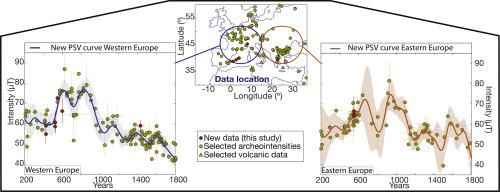Physics of the Earth and Planetary Interiors ( IF 2.4 ) Pub Date : 2021-05-29 , DOI: 10.1016/j.pepi.2021.106749 M. Rivero-Montero , M. Gómez-Paccard , F.J. Pavón-Carrasco , M.A. Cau-Ontiveros , L. Fantuzzi , F. Martín-Hernández , A. Palencia-Ortas , E. Aidona , E. Tema , D. Kondopoulou , C. Mas-Florit , J. Ramon-Torres

|
Absolute past geomagnetic intensity values can mainly be recovered by fired archaeological materials and volcanic rocks. Here, we present 10 new archeointensities from the Mediterranean region that help to better constrain geomagnetic field intensity changes in Europe over the last two millennia. The new archeointensity results were obtained from the Thellier classical method including thermoremanent magnetization (pTRM) checks and both the TRM anisotropy and cooling rate corrections and were derived from at least three specimens. The new data presented, together with a selection of previous archeointensities satisfying a set of quality criteria, confirm the presence of several intensity maxima in Europe over the last 2000 years. In particular, the new archeointensities allow to better define the starting point of the double-oscillation feature that occurred in Europe during the second half of the first millennium CE, and reinforce the existence of a relative maximum at the end of the 14th century - beginning of the 15th century in Western Europe. From selected European archeointensities two new paleosecular variation curves are constructed for Western and Eastern Europe using temporal cubic b-splines in a bootstrap approach. The obtained curves suggest that the occurrence of the intensity maxima is characterized by a period of about 300 ± 50 years. In addition, our results suggest that the maxima do not occur simultaneously in Western and Eastern Europe, pointing out an intensity eastward drift with a mean lag-time of about 100 years.
中文翻译:

细化公元 200 年至公元 1800 年欧洲的地磁场强度变化。地中海地区的新数据
过去的绝对地磁强度值主要可以通过烧制的考古材料和火山岩来恢复。在这里,我们展示了来自地中海地区的 10 个新的考古强度,它们有助于更好地限制过去两千年欧洲地磁场强度的变化。新的考古强度结果是从 Thellier 经典方法获得的,包括热剩磁 (pTRM) 检查以及 TRM 各向异性和冷却速率校正,并且来自至少三个样本。提供的新数据以及满足一组质量标准的一系列先前的考古强度,证实了过去 2000 年欧洲存在几个强度最大值。特别是,新的原始强度可以更好地定义公元第一个千年后半期发生在欧洲的双振荡特征的起点,并加强了 14 世纪末 - 15 世纪初的相对最大值的存在世纪在西欧。从选定的欧洲考古强度中,使用自举方法中的时间三次 b 样条为西欧和东欧构建了两条新的古世俗变化曲线。获得的曲线表明强度最大值的出现以大约 300 ± 50 年的周期为特征。此外,我们的结果表明,最大值不会同时出现在西欧和东欧,表明强度向东漂移,平均滞后时间约为 100 年。









































 京公网安备 11010802027423号
京公网安备 11010802027423号